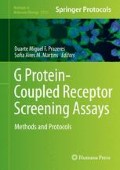Abstract
G protein-coupled receptors (GPCRs) modulate cellular signaling, often in a ligand-specific manner. Cellular effects regulated include differentiation, proliferation, hormonal regulation, and neuronal activity. Further, they are involved in many disease-relevant processes, such as cancer and neurodevelopmental diseases, and represent the largest class of drug targets. Therefore, monitoring how GPCRs are regulated in their activity is crucial to understand their role in physiological processes and implications for drug development. Split TEV, a method based on TEV protease fragment complementation, can be used to sensitively assay GPCR activities in living cells. The activity of a given GPCR is monitored through its binding to β-arrestin. Split TEV reporters provide at minimum a two-step amplification process facilitating a flexible format and a robust readout. For the initial setup, a GPCR of interest and β-arrestin are fused to the N- and C-terminal fragments of the TEV protease, and occurred interactions are indicated by increased fluorescence or luminescence of TEV cleavage-dependent reporters. The experimental procedure takes 24–72 h to complete, depending on the cell type and complexity of the experimental setup applied.
Access this chapter
Tax calculation will be finalised at checkout
Purchases are for personal use only
References
Dorsam RT, Gutkind JS (2007) G-protein-coupled receptors and cancer. Nat Rev Cancer 7:79–94. doi:10.1038/nrc2069
Heng BC, Aubel D, Fussenegger M (2013) An overview of the diverse roles of G-protein coupled receptors (GPCRs) in the pathophysiology of various human diseases. Biotechnol Adv 31:1676–1694. doi:10.1016/j.biotechadv.2013.08.017
Stevens RC, Cherezov V, Katritch V et al (2013) The GPCR Network: a large-scale collaboration to determine human GPCR structure and function. Nat Rev Drug Discov 12:25–34. doi:10.1038/nrd3859
Billingsley ML (2008) Druggable targets and targeted drugs: enhancing the development of new therapeutics. Pharmacology 82:239–244. doi:10.1159/000157624
Lagerström MC, Schiöth HB (2008) Structural diversity of G protein-coupled receptors and significance for drug discovery. Nat Rev Drug Discov 7:339–357. doi:10.1038/nrd2518
Rajagopal K, Lefkowitz RJ, Rockman HA (2005) When 7 transmembrane receptors are not G protein-coupled receptors. J Clin Invest 115:2971–2974. doi:10.1172/JCI26950
Barak LS, Ferguson SS, Zhang J, Caron MG (1997) A beta-arrestin/green fluorescent protein biosensor for detecting G protein-coupled receptor activation. J Biol Chem 272:27497–27500
Ghosh RN, DeBiasio R, Hudson CC et al (2005) Quantitative cell-based high-content screening for vasopressin receptor agonists using transfluor technology. J Biomol Screen 10:476–484. doi:10.1177/1087057105274896
Hamdan FF, Audet M, Garneau P et al (2005) High-throughput screening of G protein-coupled receptor antagonists using a bioluminescence resonance energy transfer 1-based beta-arrestin2 recruitment assay. J Biomol Screen 10:463–475. doi:10.1177/1087057105275344
Vrecl M, Jorgensen R, Pogacnik A, Heding A (2004) Development of a BRET2 screening assay using beta-arrestin 2 mutants. J Biomol Screen 9:322–333. doi:10.1177/1087057104263212
Yan Y-X, Boldt-Houle DM, Tillotson BP et al (2002) Cell-based high-throughput screening assay system for monitoring G protein-coupled receptor activation using beta-galactosidase enzyme complementation technology. J Biomol Screen 7:451–459. doi:10.1177/108705702237677
Zhao X, Jones A, Olson KR et al (2008) A homogeneous enzyme fragment complementation-based beta-arrestin translocation assay for high-throughput screening of G-protein-coupled receptors. J Biomol Screen 13:737–747. doi:10.1177/1087057108321531
Zhao C, YIN Q, Li S (2010) A high-throughput screening system for G-protein-coupled receptors using β-lactamase enzyme complementation technology. Acta Pharmacol Sin 31:1618–1624. doi:10.1038/aps.2010.154
Barnea G, Strapps W, Herrada G et al (2008) The genetic design of signaling cascades to record receptor activation. Proc Natl Acad Sci U S A 105:64–69. doi:10.1073/pnas.0710487105
Djannatian MS, Galinski S, Fischer TM, Rossner MJ (2011) Studying G protein-coupled receptor activation using split-tobacco etch virus assays. Anal Biochem 412:141–152. doi:10.1016/j.ab.2011.01.042
Wehr MC, Laage R, Bolz U et al (2006) Monitoring regulated protein-protein interactions using split TEV. Nat Methods 3:985–993. doi:10.1038/nmeth967
Wehr M, Reinecke L, Botvinnik A, Rossner M (2008) Analysis of transient phosphorylation-dependent protein-protein interactions in living mammalian cells using split-TEV. BMC Biotechnol 8:55. doi:10.1186/1472-6750-8-55
Genevet A, Wehr MC, Brain R et al (2010) Kibra is a regulator of the Salvador/Warts/Hippo signaling network. Dev Cell 18:300–308. doi:10.1016/j.devcel.2009.12.011
Wehr MC, Holder MV, Gailite I et al (2013) Salt-inducible kinases regulate growth through the Hippo signalling pathway in Drosophila. Nat Cell Biol 15:61–71. doi:10.1038/ncb2658
Botvinnik A, Wichert SP, Fischer TM, Rossner MJ (2010) Integrated analysis of receptor activation and downstream signaling with EXTassays. Nat Methods 7:74–80. doi:10.1038/nmeth.1407
Michnick SW, Ear PH, Manderson EN et al (2007) Universal strategies in research and drug discovery based on protein-fragment complementation assays. Nat Rev Drug Discov 6:569–582. doi:10.1038/nrd2311
Kapust RB, Tözsér J, Fox JD et al (2001) Tobacco etch virus protease: mechanism of autolysis and rational design of stable mutants with wild-type catalytic proficiency. Protein Eng 14:993–1000
Nunn CM, Jeeves M, Cliff MJ et al (2005) Crystal structure of tobacco etch virus protease shows the protein C terminus bound within the active site. J Mol Biol 350:145–155. doi:10.1016/j.jmb.2005.04.013
Stark C, Breitkreutz B-J, Reguly T et al (2006) BioGRID: a general repository for interaction datasets. Nucleic Acids Res 34:D535–D539. doi:10.1093/nar/gkj109
Acknowledgment
This work was supported by the Max Planck Society and the BMBF grant VIP005.
Author information
Authors and Affiliations
Corresponding authors
Editor information
Editors and Affiliations
Rights and permissions
Copyright information
© 2015 Springer Science+Business Media New York
About this protocol
Cite this protocol
Wehr, M.C., Galinski, S., Rossner, M.J. (2015). Monitoring G Protein-Coupled Receptor Activation Using the Protein Fragment Complementation Technique Split TEV. In: Prazeres, D.M.F., Martins, S.A.M. (eds) G Protein-Coupled Receptor Screening Assays. Methods in Molecular Biology, vol 1272. Humana, New York, NY. https://doi.org/10.1007/978-1-4939-2336-6_8
Download citation
DOI: https://doi.org/10.1007/978-1-4939-2336-6_8
Published:
Publisher Name: Humana, New York, NY
Print ISBN: 978-1-4939-2335-9
Online ISBN: 978-1-4939-2336-6
eBook Packages: Springer Protocols

